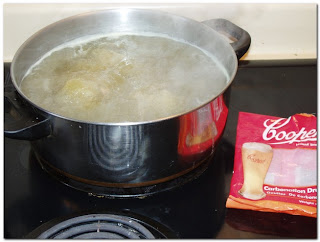Just received my latest addition of
Brew Your Own magazine and was happy to see the 'Last Call' article about the brew school I teach at Cabrillo College. For those that don't have a subscription to BYO you can order one through this blog by clicking on the link at the bottom of this page. In the mean time read the unedited version of the article here.
 |
| Students studying the basics of brewing |
Homebrewer takes his passion to the classroom
Ten years ago I caught the homebrewing bug after attending an afternoon demonstration at the local homebrew supply store here in Santa Cruz, California. It was a beautiful spring day and grain was mashing in the tun when I arrived at Seven Bridges Cooperative. A small clutch of us gathered around a modest brew rig, asking simple questions and taking in the aroma of malt and hops. Remembering back on that day I don't think I understood much from the explanations we were given and attributed my fascination with the days events to be a combination of the artistry on display and what seemed like sublime alchemy. I immediately bought a beginners kit and the basic equipment to brew up an extract batch of beer. I haven't stopped since, expanding on my knowledge and abilities from one batch to the next. Most of what I've learned over the subsequent years has come from getting involved in my local homebrew club, the Zymurgeeks, reading brewing literature, participating in on-line forums and diligently practicing the craft.
A couple of years ago it occured to me what a benefit it was to have been introduced to this great hobby in such a hands-on way, and that others like myself could benefit from the structure of a classroom environment to learn to brew. I noticed a gap between schools for the professional brewer, like Siebel Institute and U.C. Davis, and the occasional local homebrew store demonstrations. It also seemed like it would be an asset to the community plus a chance for me to share my knowledge and passion for homebrewing.
Based on this premise I developed a curiculum for a comprehensive yet practical program, a five day course for teaching homebrewing that could be offered through community college extension classes. Once my idea was developed, I mailed out application letters with my proposal to half a dozen nearby schools.
 |
| Class photo |
Cabrillo College in Soquel showed an interest after some initial reluctance over a concern that the subject would not draw the needed interest, but the class soon filled with eager students and I scheduled the first series. The course is scheduled for five Sundays in a row utilizing the week between classes for beer to ferment and the students to integrate the lessons and/or practice on their own at home. Each lesson builds upon the previous, taking the students from the basics of brewing with dry malt extract and steeping grains, continuing through the more advanced knowledge of partial mash brewing and finally brewing ten gallons of an all-grain batch. All participants get the chance to have hands on experience with the equipment and materials used in brewing, chilling, fermenting, bottling and kegging, along with the academics of the basic calculations used for testing efficiencies, attenuation, alcohol content and much more. In addition, consideration of the malt bill, hop utilization and yeast selection for developing their own recipes beyond the introductory kits available at the local homebrew store is studied. As a class, we also sample beer styles, homebrew and commercial examples, with an emphasis on sensory evaluation techniques. On the fifth and final day of class the students bring in food to pair with three of the four beers that they brewed in class, enjoying the satisfaction of sampling the results and to critically evaluate the 'fruits' of their labor.
I have been teaching this class for three years now and it continues to be popular and well received, getting good follow up reviews from the students. This is partly due, I believe, because it gives them an opportunity to directly experience the brewing process, a chance to test the waters, so to speak without a commitment to the hobby or to the initial costs of equipment and materials. Many students continue with the hobby and become actively involved in the local brewing community.
I feel proud to be able to offer this class through an organization that recognizes the value of homebrewing.
Student testimonial-
"That was a great class. You did such a good job of making the process of brewing at home comprehensible without oversimplifying, and showing us we could all do it. The more brewers in the world, the better! Thanks for sharing all your knowledge and experience with us."












































